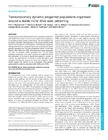Transcriptionally dynamic progenitor populations organised around a stable niche drive axial patterning
dc.contributor.author
Wymeersch, Filip J.
dc.contributor.author
Skylaki, Stavroula
dc.contributor.author
Huang, Yali
dc.contributor.author
Watson, Julia A.
dc.contributor.author
Economou, Constantinos
dc.date.accessioned
2019-02-05T15:33:55Z
dc.date.available
2019-01-12T12:06:28Z
dc.date.available
2019-02-05T15:33:55Z
dc.date.issued
2019-01-02
dc.identifier.issn
0950-1991
dc.identifier.issn
1477-9129
dc.identifier.other
10.1242/dev.168161
en_US
dc.identifier.uri
http://hdl.handle.net/20.500.11850/315282
dc.identifier.doi
10.3929/ethz-b-000315282
dc.description.abstract
The elongating mouse anteroposterior axis is supplied by progenitors with distinct tissue fates. It is not known whether these progenitors confer anteroposterior pattern to the embryo. We have analysed the progenitor population transcriptomes in the mouse primitive streak and tail bud throughout axial elongation. Transcriptomic signatures distinguish three known progenitor types (neuromesodermal, lateral/paraxial mesoderm and notochord progenitors; NMPs, LPMPs and NotoPs). Both NMP and LPMP transcriptomes change extensively over time. In particular, NMPs upregulate Wnt, Fgf and Notch signalling components, and many Hox genes as progenitors transit from production of the trunk to the tail and expand in number. In contrast, the transcriptome of NotoPs is stable throughout axial elongation and they are required for normal axis elongation. These results suggest that NotoPs act as a progenitor niche whereas anteroposterior patterning originates within NMPs and LPMPs.
en_US
dc.format
application/pdf
en_US
dc.language.iso
en
en_US
dc.publisher
Company of Biologists
en_US
dc.rights.uri
http://creativecommons.org/licenses/by/4.0/
dc.subject
Mouse
en_US
dc.subject
Neuromesodermal
en_US
dc.subject
Lateral and paraxial mesoderm
en_US
dc.subject
Notochord progenitors
en_US
dc.subject
Hox
en_US
dc.title
Transcriptionally dynamic progenitor populations organised around a stable niche drive axial patterning
en_US
dc.type
Journal Article
dc.rights.license
Creative Commons Attribution 4.0 International
dc.date.published
2018-12-17
ethz.journal.title
Development
ethz.journal.volume
146
en_US
ethz.journal.issue
1
en_US
ethz.journal.abbreviated
Development
ethz.pages.start
dev168161
en_US
ethz.size
16 p.
en_US
ethz.version.deposit
publishedVersion
en_US
ethz.identifier.wos
ethz.identifier.scopus
ethz.publication.place
Cambridge
en_US
ethz.publication.status
published
en_US
ethz.date.deposited
2019-01-12T12:06:31Z
ethz.source
SCOPUS
ethz.eth
yes
en_US
ethz.availability
Open access
en_US
ethz.rosetta.installDate
2019-02-05T15:34:19Z
ethz.rosetta.lastUpdated
2023-02-06T16:49:23Z
ethz.rosetta.versionExported
true
ethz.COinS
ctx_ver=Z39.88-2004&rft_val_fmt=info:ofi/fmt:kev:mtx:journal&rft.atitle=Transcriptionally%20dynamic%20progenitor%20populations%20organised%20around%20a%20stable%20niche%20drive%20axial%20patterning&rft.jtitle=Development&rft.date=2019-01-02&rft.volume=146&rft.issue=1&rft.spage=dev168161&rft.issn=0950-1991&1477-9129&rft.au=Wymeersch,%20Filip%20J.&Skylaki,%20Stavroula&Huang,%20Yali&Watson,%20Julia%20A.&Economou,%20Constantinos&rft.genre=article&rft_id=info:doi/10.1242/dev.168161&
Files in this item
Publication type
-
Journal Article [128857]

